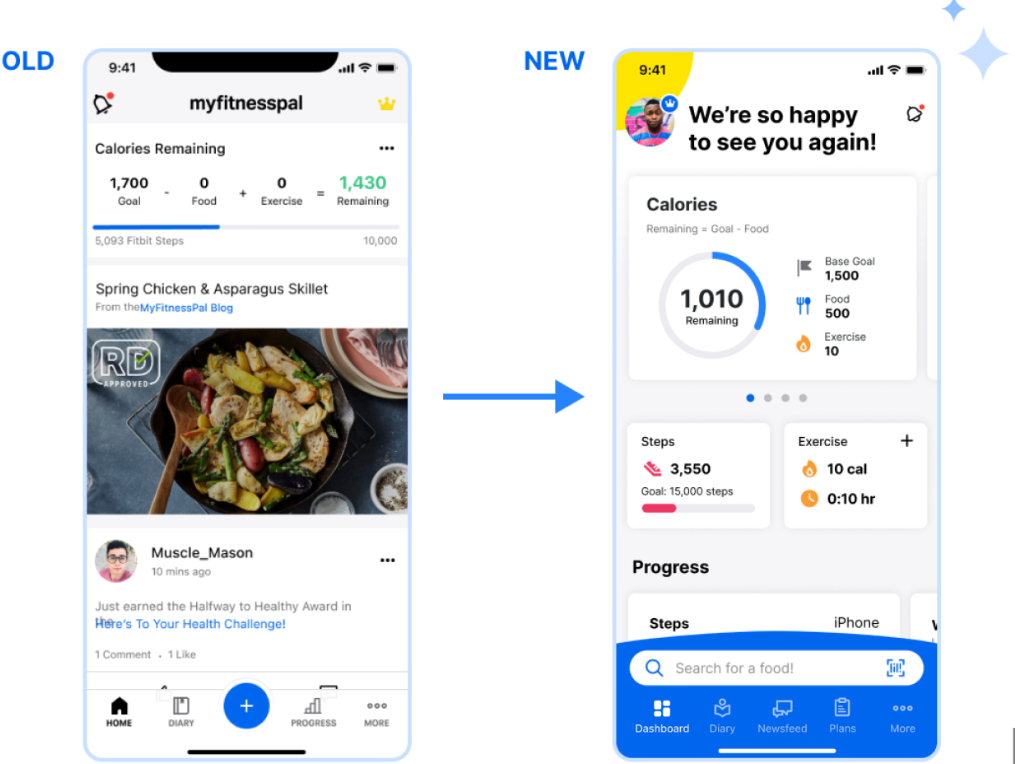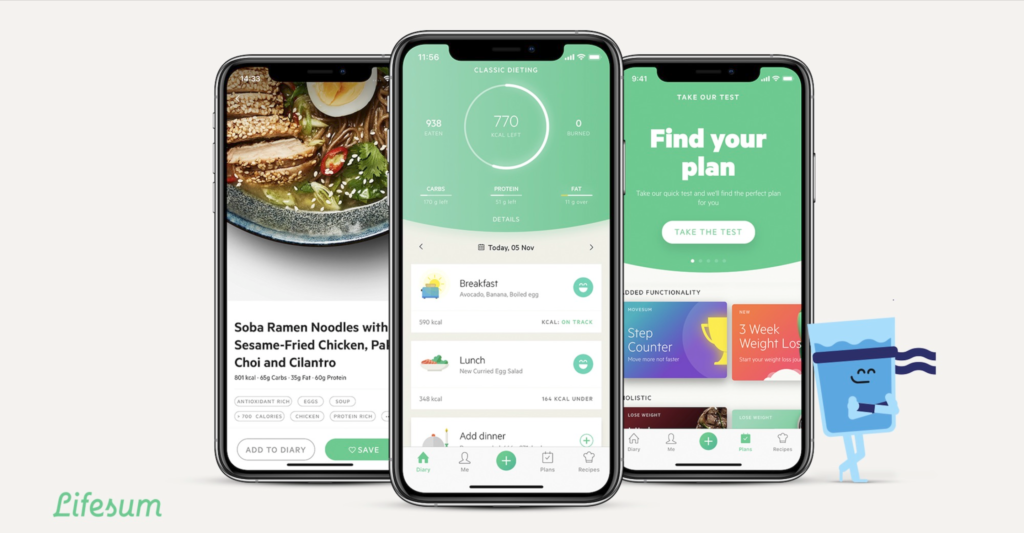MyFitnessPal vs Lifesum
In the dynamic realm of health and fitness, the choice between MyFitnessPal vs Lifesum can significantly impact your journey towards well-being. When it comes to achieving health and fitness goals, having the right diet tracking app is paramount. Today, we delve into a comprehensive comparison of two leading players in this arena: MyFitnessPal and Lifesum. Exploring their features, personal experiences, pricing structures, and pros and cons, this analysis aims to guide you in selecting the optimal app for your dietary journey. Alongside our insights, visual snapshots of each app’s interface and key features provide an immersive look into the user experience.
Table of Contents

Quick Comparison
In a nutshell, both MyFitnessPal and Lifesum offer robust features to help users track their nutrition and exercise. MyFitnessPal is renowned for its extensive database and social community, while Lifesum takes a personalized approach with tailored diet plans and a unique “Life Score” feature.
Features
MyFitnessPal
MyFitnessPal distinguishes itself with an expansive suite of features dedicated to meticulous food and exercise tracking. Boasting an unparalleled food database, users can effortlessly log meals, aided by a convenient barcode scanner for packaged items. The social facet of the app fosters a supportive community, encouraging shared progress and motivation. Furthermore, MyFitnessPal seamlessly integrates with various fitness devices, elevating the tracking experience to new heights. Premium features include advanced tools such as macro tracking and in-depth food analysis, offering users an enhanced and comprehensive approach to their health journey.

Lifesum
Lifesum takes a personalized approach, elevating the diet tracking experience with features that go beyond the conventional. The app crafts individualized diet plans tailored to specific goals and preferences, providing users with a roadmap for sustainable and personalized nutrition. Going above and beyond food and exercise tracking, Lifesum introduces innovative elements like water intake and daily step monitoring, offering users a more holistic perspective on their overall well-being. The standout feature, the “Life Score,” uniquely evaluates lifestyle choices, setting Lifesum apart as a comprehensive wellness companion. Premium users enjoy additional benefits such as more personalized insights and an ad-free environment, enhancing the overall user experience.

Personal Experience
Having immersed myself in the functionality of both MyFitnessPal and Lifesum, the distinction in user experience becomes evident.
MyFitnessPal
Navigating through MyFitnessPal, I discovered a platform that excels in providing a community-driven environment. The extensive food database and user-friendly interface make the tracking process seamless and enjoyable. The app’s social component adds an extra layer of motivation, connecting users with a like-minded community, facilitating shared achievements and encouragement. MyFitnessPal caters to individuals who thrive in an interactive and supportive tracking atmosphere, making it a top choice for those valuing both precision and community engagement in their fitness journey.
Lifesum
Conversely, Lifesum offers a personalized and holistic experience that resonates with users seeking a more tailored approach to health. The individualized diet plans proved to be invaluable, offering not just tracking but a roadmap for sustainable and personalized nutrition. Lifesum’s additional features, such as water intake and step monitoring, broaden the scope beyond conventional tracking, providing users with a comprehensive view of their well-being. The “Life Score” adds a unique touch, evaluating lifestyle choices and further emphasizing Lifesum’s commitment to a holistic and personalized health journey. For those prioritizing a more individualized and all-encompassing approach, Lifesum stands out as a noteworthy contender in the realm of diet tracking apps.
Pricing
When it comes to the pricing structures of MyFitnessPal vs. Lifesum, understanding the nuances can significantly impact your decision-making process.
MyFitnessPal
MyFitnessPal offers users a dual-tiered system with both free and premium versions. While the free version provides access to essential tracking features, the premium upgrade unlocks a host of advanced tools. Premium subscribers benefit from macro tracking, enabling a more nuanced understanding of nutritional intake. Additionally, premium users enjoy in-depth food analysis, allowing for a comprehensive evaluation of dietary habits. It’s important to weigh the enhanced features against the subscription cost, ensuring that the investment aligns with individual tracking needs and preferences.
Lifesum
Lifesum follows a similar model, presenting users with both free and premium versions. The free version grants access to fundamental tracking elements, while the premium subscription introduces a suite of personalized insights and an ad-free experience. For users seeking a more tailored and comprehensive approach to diet tracking, the premium version of Lifesum might prove to be a worthwhile investment. Evaluating individual tracking goals and the value derived from premium features becomes crucial in determining the most cost-effective choice for one’s health journey.
In the realm of MyFitnessPal vs. Lifesum, the pricing structure plays a pivotal role in aligning the chosen app with your unique tracking requirements and budget considerations.
Pros & Cons
MyFitnessPal
Pros:
- Extensive Food Database: MyFitnessPal boasts a vast and meticulously curated food database, simplifying the process of logging meals with accurate nutritional information.
- Active Community Support: The app fosters a robust social community where users can share achievements, seek advice, and find motivation, creating a supportive environment for their fitness journey.
- Integration with Various Fitness Devices: MyFitnessPal seamlessly integrates with a wide range of fitness devices, enhancing the overall tracking experience by syncing data from wearables and other health-related tools.
Cons:
- Limited Advanced Features in Free Version: While the free version provides essential tracking tools, some advanced features, such as macro tracking and in-depth food analysis, are reserved for premium subscribers.
- Interface Complexity: The interface, while comprehensive, might be considered complex for users who prefer a more straightforward or minimalist design.
Lifesum
Pros:
- Personalized Diet Plans: Lifesum stands out with its personalized diet plans, tailoring nutritional recommendations based on individual goals and preferences.
- Holistic “Life Score” Evaluation: The unique “Life Score” feature goes beyond traditional tracking, evaluating lifestyle choices to provide users with a more comprehensive understanding of their overall well-being.
- Water and Step Tracking: Lifesum introduces innovative elements like water intake and step tracking, offering users a more holistic perspective on their daily habits.
Cons:
- Premium Version Required for Full Access: Some of Lifesum’s standout features, including more personalized insights and an ad-free experience, are accessible only through the premium version.
- Learning Curve: The wealth of features may result in a steeper learning curve for new users compared to simpler tracking apps.
In weighing the pros and cons of MyFitnessPal vs. Lifesum, it’s crucial to consider individual preferences, tracking needs, and the importance placed on community engagement or personalized guidance in making an informed choice for your fitness journey.
Alternatives
For those considering alternatives, apps like Lose It! and Yazio also offer robust features for diet tracking. Evaluate their unique offerings to determine the best fit for your preferences and goals. This will be talked about In another blog post, but for now these are some good alternatives to keep in mind.
User-Friendly Interface
The user interface, a pivotal aspect of the MyFitnessPal vs. Lifesum comparison, plays a profound role in shaping the overall user experience. MyFitnessPal excels with its intuitive and straightforward design, offering users a seamless journey through the app’s extensive features. Navigating the app feels natural, with a clean layout that allows for easy access to various functions, making it especially appealing to those who appreciate simplicity and efficiency in their tracking experience. The vibrant and organized interface contributes to a user-friendly environment, ensuring that both newcomers and seasoned users can effortlessly navigate the app’s expansive database and community features.
In contrast, Lifesum introduces users to an interface designed to cater to those who seek a more personalized and holistic tracking experience. While maintaining an intuitive design, Lifesum’s interface offers a unique blend of functionality and aesthetics. The inclusion of personalized diet plans, water intake tracking, and the distinctive “Life Score” feature is seamlessly integrated into the interface, providing users with a comprehensive snapshot of their overall well-being. However, it’s important to note that the wealth of features in Lifesum might present a slight learning curve for users who are accustomed to simpler tracking apps.
As users delve into the intricacies of these interfaces, they are presented with distinctive visual experiences that align with their preferences—be it the simplicity of MyFitnessPal or the personalized touch of Lifesum. Ultimately, the user interface becomes a crucial element in determining which app resonates more deeply with individual tracking needs and contributes to a more enjoyable and effective health journey.
Conclusion/Summary: Who is the Winner?
In the captivating contest of MyFitnessPal vs. Lifesum, the denouement of this comparison underscores the individuality of user preferences and goals. As we traverse the features, personal experiences, pricing structures, and pros and cons, the conclusion becomes a nuanced exploration of what each app brings to the table.
MyFitnessPal emerges as a stalwart for those who thrive in a community-driven environment, valuing a vast database and user-friendly interface. Its social component fosters a sense of camaraderie, making it an ideal choice for individuals seeking not only precision in tracking but also a supportive community to share achievements and motivation.
On the other end of the spectrum, Lifesum carves its niche by offering a personalized and holistic approach to health. Tailored diet plans, water and step tracking, and the unique “Life Score” feature position Lifesum as a comprehensive wellness companion. It caters to users who prioritize not just tracking but a more nuanced understanding of their overall well-being.
Ultimately, the choice between MyFitnessPal and Lifesum hinges on personal inclinations. For those prioritizing community engagement, a vast food database, and a straightforward tracking experience, MyFitnessPal is a frontrunner. Alternatively, Lifesum caters to individuals seeking a more tailored, holistic approach to health, where tracking goes beyond the basics.
The winner, therefore, is subjective and depends on the unique preferences, tracking goals, and the desired experience of the user. Whether it’s the vibrant and supportive community of MyFitnessPal or the personalized and holistic features of Lifesum, the key lies in selecting the app that aligns seamlessly with your health journey, motivating and supporting you on your path to a healthier lifestyle.
